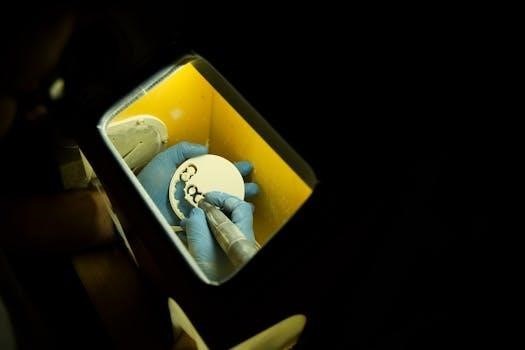Maintaining a clean Manitowoc ice machine is crucial for both hygiene and performance. Regular cleaning prevents the buildup of scale, slime, and algae, ensuring the production of safe, sanitary ice. This manual provides step-by-step instructions for effective cleaning and sanitization.
Importance of Regular Cleaning
Regular cleaning of your Manitowoc ice machine is paramount for several reasons, extending beyond mere aesthetics. First and foremost, it ensures the production of safe and sanitary ice, preventing the growth of harmful bacteria, mold, and algae that can compromise the health of your customers and staff. Neglecting cleaning can lead to the accumulation of slime and scale, fostering an environment conducive to microbial contamination.
Moreover, consistent cleaning is vital for maintaining the optimal performance and efficiency of your ice machine. Mineral buildup, particularly limescale, can impede the machine’s ability to effectively freeze water, resulting in reduced ice production and increased energy consumption. A clean machine operates more efficiently, saving you money on utility bills and preventing costly repairs down the line.
Furthermore, regular cleaning extends the lifespan of your Manitowoc ice machine. By removing corrosive buildup and preventing component damage, you can safeguard your investment and ensure years of reliable operation. A well-maintained machine is less prone to breakdowns and requires less frequent servicing, minimizing downtime and maximizing productivity. In essence, regular cleaning is not just a matter of hygiene; it’s an essential practice for ensuring the safety, efficiency, and longevity of your Manitowoc ice machine.
Approved Cleaning Solutions
Using the correct cleaning solutions is critical for maintaining the integrity and performance of your Manitowoc ice machine. Manitowoc mandates the use of specific, approved cleaning and sanitizing solutions to ensure effective cleaning without damaging the machine’s components. Typically, Manitowoc ice machine cleaner, also known as descaler, is a solution based on citric and phosphoric acid. This solution is designed to break down limescale and mineral buildup that naturally occurs within ice machines.
For sanitizing, Manitowoc recommends using an ice machine sanitizer that effectively eliminates slime, algae, and bacteria that may have accumulated since the last cleaning. It is important to always consult your Manitowoc ice machine’s user manual or the manufacturer’s website to confirm the approved cleaning and sanitizing solutions for your specific model.
Using unauthorized cleaning agents can cause damage to the machine’s internal components, void the warranty, and potentially introduce harmful chemicals into the ice. Always follow the manufacturer’s instructions for dilution and application of the approved cleaning solutions to ensure safe and effective cleaning. Furthermore, ensure you are using a nickel-safe chemical, particularly when cleaning a Manitowoc cuber. Proper selection and use of approved cleaning solutions are essential for maintaining a clean, safe, and efficient Manitowoc ice machine.
Cleaning Frequency Recommendations
Maintaining a regular cleaning schedule is paramount for the optimal performance and hygiene of your Manitowoc ice machine. Manitowoc recommends a preventative maintenance cleaning and sanitizing procedure at least every six months. However, the ideal cleaning frequency can vary based on several factors, including the machine’s usage, the water quality in your area, and the surrounding environment.
In environments with hard water, mineral buildup can occur more rapidly, necessitating more frequent cleaning. Similarly, ice machines in dusty or greasy environments may require more regular attention to prevent contamination. For high-usage machines, a cleaning and sanitizing cycle every three months is advisable to ensure consistent ice quality and prevent potential issues.
It’s crucial to monitor your ice machine for signs of buildup or contamination, such as cloudy ice, unusual odors, or reduced ice production. These indicators signal the need for immediate cleaning, regardless of the established schedule. Implementing a consistent cleaning routine not only ensures the production of safe, sanitary ice but also extends the lifespan of your Manitowoc ice machine by preventing scale buildup and maintaining optimal efficiency. Regular cleaning prevents issues and costly repairs down the line.
Exterior Cleaning Procedure
Maintaining a clean exterior for your Manitowoc ice machine is essential for hygiene and aesthetics. Before starting, disconnect the machine from its power source to ensure safety. Begin by wiping down the exterior stainless steel surfaces with a clean, damp cloth to remove any loose dirt or debris.
For more stubborn stains or grime, prepare a diluted solution of mild detergent and warm water. Apply the solution to the affected areas using a soft cloth or sponge, gently scrubbing to lift the dirt. Avoid using abrasive cleaners or scouring pads, as these can damage the stainless steel finish. After cleaning with the detergent solution, rinse the exterior thoroughly with clean water to remove any remaining residue.
Next, prepare a diluted bleach solution consisting of one tablespoon of bleach per gallon of water for sanitizing. Apply the sanitizing solution to the exterior surfaces, allowing it to sit for approximately five minutes before rinsing with clean water. Finally, dry the exterior surfaces with a clean, dry cloth to prevent water spots and maintain a polished appearance. Regular exterior cleaning not only enhances the machine’s appearance but also helps prevent the spread of bacteria and maintain a sanitary environment.
Interior Cleaning Procedure
Maintaining a clean interior is vital for the sanitary operation of your Manitowoc ice machine. Begin by emptying the ice bin and removing all ice. Next, power off the ice machine and disconnect it from the power source. Remove all removable components like water troughs, distribution tubes, and any ice-making components that are designed for easy removal, consulting your machine’s specific manual for guidance.
Prepare a cleaning solution using a nickel-safe ice machine cleaner, specifically designed for Manitowoc machines. Follow the manufacturer’s instructions for proper dilution. Thoroughly clean all interior surfaces, including the ice-making chamber, water reservoir, and any components you removed, using a soft brush or cloth. Pay special attention to areas with visible scale or slime buildup. After cleaning, rinse all surfaces and components thoroughly with clean water to ensure no cleaner residue remains.
For sanitizing, use an approved ice machine sanitizer, diluted according to the manufacturer’s instructions. Apply the sanitizer to all interior surfaces, allowing it to dwell for the recommended time before rinsing thoroughly with clean water. Reassemble the ice machine, ensuring all components are correctly in place. Finally, restart the ice machine and discard the first batch of ice produced to ensure complete removal of any residual cleaning or sanitizing solutions.
Step 1⁚ Emptying the Ice Bin and Removing Components

The initial step in cleaning your Manitowoc ice machine involves preparing the unit for the cleaning cycle. Begin by completely emptying the ice bin. This ensures that no ice is contaminated during the cleaning process and allows for thorough access to all interior surfaces. Dispose of the ice properly, avoiding its use for consumption.
Next, proceed to remove all removable components from the ice machine. This typically includes the water trough, distribution tubes, and any other parts that the manufacturer has designed for easy removal. Consult your Manitowoc ice machine’s specific model manual for detailed instructions and diagrams on how to properly remove these components. Handle each part with care to prevent damage.
Carefully inspect each removed component for mineral buildup, slime, or any other signs of contamination. These components will be thoroughly cleaned in subsequent steps. Place the removed components in a clean, sanitized container or sink for washing. Ensure that you have adequate space to clean each part effectively. This preparation is essential for a comprehensive cleaning process.
Step 2⁚ Activating the Cleaning Cycle
After emptying the ice bin and removing the necessary components, the next crucial step is to activate the cleaning cycle on your Manitowoc ice machine. The process for initiating the cleaning cycle can vary slightly depending on the specific model of your machine, so it is essential to refer to your user manual for precise instructions.
Typically, Manitowoc ice machines are equipped with a designated “Clean” button or setting on the control panel. This might involve pressing a button, toggling a switch, or navigating through a digital menu. Ensure the machine is in the correct mode for cleaning before proceeding.
For models with a touchpad, locate the “CLEAN” button on the NEO touchpad. Some older models might have a physical “clean/ice” switch. If your machine has such a switch, ensure it is set to the “clean” position. Note that some machines will stay in clean mode for a set duration once activated, regardless of switching back to “ice” or “off.”
Once the cleaning cycle is initiated, the machine will typically begin to prepare for the introduction of the cleaning solution. This might involve draining the water reservoir or initiating a preliminary rinse cycle. Be patient and allow the machine to complete its preparations before moving on to the next step.

Step 3⁚ Adding the Cleaning Solution
With the cleaning cycle activated, the next critical step is to introduce the appropriate cleaning solution into the Manitowoc ice machine. It is imperative to use only Manitowoc-approved cleaning solutions, also called descalers, specifically designed for ice machines. These solutions are typically a blend of citric and phosphoric acids, formulated to safely and effectively break down limescale and mineral buildup without damaging the machine’s components.
Carefully measure the recommended amount of cleaning solution as indicated in your ice machine’s manual and the cleaning solution’s instructions. Using too much or too little solution can compromise the cleaning process and potentially harm the machine.
Locate the designated fill area for the cleaning solution. This is usually a reservoir or basin within the ice machine’s interior. Slowly and carefully pour the measured cleaning solution into the fill area, avoiding any spills.
After adding the solution, some machines might require you to add water to dilute the cleaner. Consult your manual for the correct water-to-cleaner ratio. Once the solution is in place, ensure the machine is ready to proceed with the cleaning cycle before moving on to the next step.
Step 4⁚ Waiting for the Cleaning Cycle to Complete

After adding the cleaning solution, patience is key. The Manitowoc ice machine’s cleaning cycle needs sufficient time to effectively circulate the solution, dissolve mineral deposits, and sanitize internal components. The duration of the cleaning cycle varies depending on the model, but it typically lasts around 25 to 30 minutes.
During this period, avoid interrupting the cleaning process. Do not open the ice machine or attempt to switch it back to ice-making mode. Allow the machine to run its full cleaning cycle uninterrupted. Some models may have an indicator light or display that shows the cleaning cycle’s progress.
While waiting, take the opportunity to clean the removed components, such as the ice bin, using warm water and a mild detergent. Rinse them thoroughly and allow them to air dry. This ensures that all parts of the ice machine are clean and ready for operation after the cycle is complete.
Once the cleaning cycle is finished, the machine will usually alert you, either by turning off the cleaning light or through an audible signal. Only then should you proceed to the next steps in the cleaning and sanitizing procedure.
Sanitizing Procedure
Following the cleaning cycle, sanitizing is crucial to eliminate any remaining bacteria, slime, and algae within the Manitowoc ice machine. Use only Manitowoc-approved sanitizer or a nickel-safe alternative, carefully following the manufacturer’s instructions for dilution. Typically, this involves mixing the sanitizer with water to create a sanitizing solution.
Once the sanitizing solution is prepared, initiate a sanitizing cycle on your ice machine, if available. Otherwise, manually introduce the solution into the machine, ensuring it reaches all interior surfaces that come into contact with ice. Allow the solution to circulate for the recommended time, usually around 10-15 minutes.
After the sanitizing cycle, thoroughly rinse all interior surfaces with clean, potable water to remove any residual sanitizer. This step is essential to prevent any sanitizer from contaminating the ice produced. Ensure that all traces of the sanitizing solution are completely flushed out.
Finally, allow the ice machine to air dry completely before reassembling any removed components and resuming ice production. This prevents the growth of mold or bacteria due to moisture. Regular sanitization, along with cleaning, guarantees the safety and quality of the ice produced.
Troubleshooting Cleaning Cycle Issues
Encountering problems during the cleaning cycle of your Manitowoc ice machine can be frustrating, but many issues have simple solutions. If the “clean” light remains on even after the cycle is supposedly complete, ensure the cycle ran for the full duration (typically 25 minutes). Prematurely switching back to “ice” or “off” can interrupt the process.
If the machine fails to initiate the cleaning cycle altogether, check the power supply and ensure the machine is properly connected. Also, verify that the water inlet valve is open and supplying water to the machine. Low water pressure can also prevent the cycle from starting.
Another common issue is inadequate cleaning. This may be due to using an insufficient amount of cleaning solution or a solution that is too diluted. Always adhere to the manufacturer’s instructions for proper dilution ratios. If scale buildup is particularly heavy, a second cleaning cycle may be necessary.
In some cases, error codes may appear on the control panel. Consult your machine’s manual to identify the meaning of the code and follow the recommended troubleshooting steps. If problems persist, contacting a qualified ice machine technician is advised.
Cleaning the Condenser
The condenser is a vital component of your Manitowoc ice machine, responsible for dissipating heat and maintaining optimal cooling performance. A dirty condenser restricts airflow, causing the machine to work harder, consume more energy, and potentially overheat. Regular cleaning is essential to prevent these issues and extend the lifespan of your ice machine.
Before cleaning, disconnect the power supply to the machine to prevent electrical hazards. Locate the condenser, which is typically found at the rear or side of the unit. Use a vacuum cleaner with a brush attachment to remove loose dust, dirt, and debris from the condenser fins. For stubborn buildup, a fin comb can be used to gently straighten bent fins and dislodge debris.
In cases of heavy grease or grime accumulation, a specialized condenser cleaner may be necessary. Apply the cleaner according to the manufacturer’s instructions, being careful to avoid contact with electrical components. Allow the cleaner to dwell for the recommended time, then rinse thoroughly with clean water. Ensure the condenser is completely dry before reconnecting the power supply. Regular condenser cleaning, ideally every three to six months, ensures efficient operation and prevents costly repairs.
Cleaning the Air Filter
The air filter in your Manitowoc ice machine plays a critical role in maintaining optimal performance and ice quality. It prevents dust, dirt, and other airborne particles from entering the machine and contaminating the ice-making process. A clogged or dirty air filter restricts airflow, causing the machine to work harder, consume more energy, and potentially produce cloudy or contaminated ice. Regular cleaning or replacement of the air filter is therefore essential.
To clean the air filter, first, locate it. It’s typically situated at the front or side of the unit, often behind a removable panel. Remove the filter carefully, noting its orientation for proper reinstallation. Use a vacuum cleaner with a brush attachment to remove loose dust and debris. For more thorough cleaning, wash the filter with mild soap and warm water. Rinse it thoroughly to remove all soap residue.
Allow the air filter to air dry completely before reinstalling it. Never operate the ice machine without a clean and dry air filter in place. Depending on the environment and usage, the air filter should be cleaned every one to three months. Replace the filter if it becomes damaged or excessively soiled. Regular air filter maintenance ensures efficient ice production and clean, safe ice.

